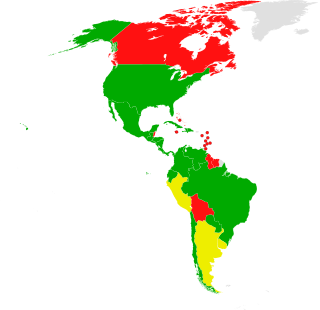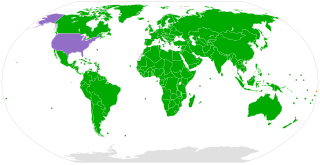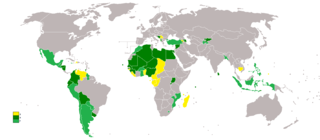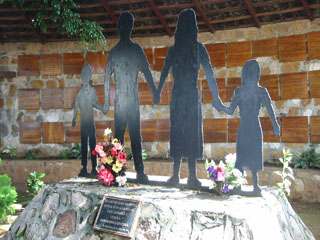
The Montevideo Convention on the Rights and Duties of States is a treaty signed at Montevideo, Uruguay, on December 26, 1933, during the Seventh International Conference of American States. The Convention codifies the declarative theory of statehood as accepted as part of customary international law. At the conference, United States President Franklin D. Roosevelt and Secretary of State Cordell Hull declared the Good Neighbor Policy, which opposed U.S. armed intervention in inter-American affairs. The convention was signed by 19 states. The acceptance of three of the signatories was subject to minor reservations. Those states were Brazil, Peru and the United States.

The United Nations Convention on the Rights of the Child is a human rights treaty which sets out the civil, political, economic, social, health and cultural rights of children. The Convention defines a child as any human being under the age of eighteen, unless the age of majority is attained earlier under national legislation.
The American Declaration of the Rights and Duties of Man, also known as the Bogota Declaration, was the world's first international human rights instrument of a general nature, predating the Universal Declaration of Human Rights by less than a year.

The Hague Conventions of 1899 and 1907 are a series of international treaties and declarations negotiated at two international peace conferences at The Hague in the Netherlands. Along with the Geneva Conventions, the Hague Conventions were among the first formal statements of the laws of war and war crimes in the body of secular international law. A third conference was planned for 1914 and later rescheduled for 1915, but it did not take place due to the start of World War I.
The Protocol to Prevent, Suppress and Punish Trafficking in Persons, Especially Women and Children is a protocol to the Convention against Transnational Organised Crime. It is one of the three Palermo protocols, the others being the Protocol against the Smuggling of Migrants by Land, Sea and Air and the Protocol against the Illicit Manufacturing and Trafficking in Firearms.
The 1926 Slavery Convention or the Convention to Suppress the Slave Trade and Slavery was an international treaty created under the auspices of the League of Nations and first signed on 25 September 1926. It was registered in League of Nations Treaty Series on 9 March 1927, the same day it went into effect. The objective of the Convention was to confirm and advance the suppression of slavery and the slave trade.

The International Convention on the Protection of the Rights of All Migrant Workers and Members of Their Families is a United Nations multilateral treaty governing the protection of migrant workers and families. Signed on 18 December 1990, it entered into force on 1 July 2003 after the threshold of 20 ratifying States was reached in March 2003. The Committee on Migrant Workers (CMW) monitors implementation of the convention, and is one of the seven UN-linked human rights treaty bodies.

Human rights are comprehensively guaranteed in Switzerland, one of Europe's oldest democracies. Together with other European states, Switzerland is often at or near the head in international civil liberties and political rights rankings. Switzerland places human rights at the core of the nation's value system, as represented in the Federal Constitution and political model. Promotion of peace, mutual respect, equality and non-discrimination are central to the country's democratic election.

The Inter-American Convention to Prevent and Punish Torture (IACPPT) is an international human rights instrument, created in 1985 within the Western Hemisphere Organization of American States and intended to prevent torture and other similar activities.

The International Convention for the Protection of All Persons from Enforced Disappearance (ICPPED) is an international human rights instrument of the United Nations and intended to prevent forced disappearance defined in international law, crimes against humanity. The text was adopted by the United Nations General Assembly on 20 December 2006 and opened for signature on 6 February 2007. It entered into force on 23 December 2010. As of September 2018, 98 states have signed the convention and 59 have ratified it.

The Optional Protocol to the Convention on the Rights of Persons with Disabilities is a side-agreement to the Convention on the Rights of Persons with Disabilities. It was adopted on 13 December 2006, and entered into force at the same time as its parent Convention on 3 May 2008. As of December 2018, it has 93 signatories and 94 state parties.

The Optional Protocol to the International Covenant on Economic, Social and Cultural Rights is an international treaty establishing complaint and inquiry mechanisms for the International Covenant on Economic, Social and Cultural Rights. It was adopted by the UN General Assembly on 10 December 2008, and opened for signature on 24 September 2009. As of October 2018, the Protocol has 45 signatories and 24 state parties. It entered into force on 5 May 2013.

The First Optional Protocol to the International Covenant on Civil and Political Rights is an international treaty establishing an individual complaint mechanism for the International Covenant on Civil and Political Rights (ICCPR). It was adopted by the UN General Assembly on 16 December 1966, and entered into force on 23 March 1976. As of January 2018, it had 3 signatories and 116 states parties. Two of the ratifying states—Jamaica and Trinidad and Tobago—have denounced the protocol.

Human rights in the United States comprise a series of rights which are legally protected by the Constitution of the United States, including the amendments, state constitutions, conferred by treaty and customary international law, and enacted legislatively through Congress, state legislatures, and state referenda and citizen's initiatives. Federal courts in the United States have jurisdiction over international human rights laws as a federal question, arising under international law, which is part of the law of the United States.
The Committee on the Rights of Persons with Disabilities (CRPD) is a United Nations body of 18 experts that meets two times a year in Geneva to consider the reports submitted by 153 UN member states on their compliance with the Convention on the Rights of Persons with Disabilities, and to examine individual petitions concerning 85 States Parties to the Optional Protocol.
The Inter-American Convention on The Forced Disappearance of Persons is a treaty of the Organization of American States (OAS) intended to combat the forced disappearance of persons. The Convention was adopted in 1994. Ratification is open to all members of the OAS and as of 2014, the convention has been ratified by 15 states. Violations of the convention can be brought to the Inter-American Commission on Human Rights.














